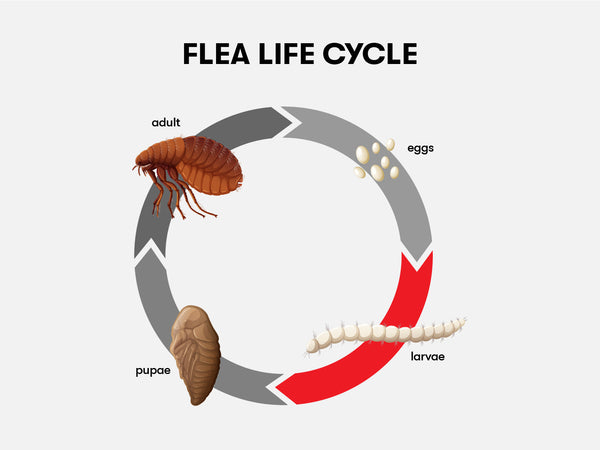Pet Food All Life Stages for Dogs & Cats
Written by: Dr. Jean Hofve, Holistic Veterinarian, DVM
What Are Life Stages?
One of the features on a pet food label is the designation for "life stage." You may have never noticed this detail, because it's often in very small print (especially on cans), and it may be buried at the end of the ingredient list. But it's crucial to understand this concept.
"Of course, puppies and kittens do have different nutritional needs than adults. For example, their rapid growth requires a lot of energy (calories), and they get lactose and other carbohydrates in their mother's milk to provide energy in an instantly absorbable form."
Pet foods are commonly labeled for puppies, kittens, adults, and even mature and senior pets. Many pet food manufacturers push the "niche marketing" concept even further, combining age with specific breeds, health issues, and lifestyles, such as "Brand Q adult indoor overweight Persian cat food" or "Brand Z active senior brindle Boxer dog food." (Okay, those are exaggerated... but not by much!)
Of course, puppies and kittens do have different nutritional needs than adults. For example, their rapid growth requires a lot of energy (calories), and they get lactose and other carbohydrates in their mother's milk to provide energy in an instantly absorbable form.
The basic life stages recognized by AAFCO (Association of American Feed Control Officials), the organization that sets the standards used by US pet food manufacturers, are Adult Maintenance, and Growth/Reproduction. The latter includes everything that isn't simple adult maintenance: gestation (pregnancy), lactation (nursing) and growth (puppies and kittens). Foods can be labeled for one or more of these stages. A food labeled for "all life stages" must meet the more stringent nutritional requirements for growth and reproduction.
On the label, you're looking for the "AAFCO Statement." The language is required and specific, and no variations are allowed. Any claim that a pet food provides complete and balanced nutrition must state one of the following:
"(Name of product) is formulated to meet the nutritional levels established by the AAFCO dog (or Cat) Food Nutrient Profiles for (life stage or stages)" (gestation/lactation, growth, maintenance, or the words "All Life Stages").
-OR-
"Animal feeding tests using AAFCO procedures substantiate that (Name of Product) provides complete and balanced nutrition for (life stage)."
-OR-
"(Name of Product) provides complete and balanced nutrition for (life stage) and is comparable in nutritional adequacy to a product which has been substantiated using AAFCO feeding tests."
Additionally, if a claim is made for "growth" or "all life stages" on a dog food, one of the following phrases must also be added verbatim to the end of the claim: "including growth of large size dogs (70 lbs. or more as an adult)," or "except for growth of large size dogs (70 lbs. or more as an adult)."
If a food does not meet the requirements for a complete and balanced food, then the label must state: "This product is intended for intermittent and supplemental feeding only."
How Life Stages are Determined?
To meet the standards for "complete and balanced" at any life stage, a pet food must do one of two things:
-
Meet, either by formulation or chemical analysis, the nutritional standards set by AAFCO, the Dog Food and Cat Food Nutrient Profiles. These Profiles contain two columns of requirements for each nutrient: Growth and Reproduction (lumped together for this purpose), and Adult Maintenance. No distinction is made between growth (puppies) and reproduction (both gestation and lactation). A food made for "All Life Stages" must meet the more stringent growth requirements.
-
Be proven nutritionally adequate by going through a feeding test. A feeding test requires that at least 8 animals begin the test and at least 6 must finish it with satisfactory weight gain, body condition, and blood test minimums. The test lasts 6 months for adults, 10 weeks for growth, and from estrus to 4 weeks post-partum (about 13 weeks) for reproduction.
Differences Between Life Stages
So, exactly what are the differences between adult and growth/reproduction foods? The primary changes are:
-
Protein
Protein is made up of building blocks called amino acids. Twelve amino acids and the total amount of protein are higher for growth/reproduction and all life stages than for adult maintenance in dogs; and 11 out of 12 amino acids are higher for kittens. Taurine is not required for dogs, although it is for cats; but the level is the same across all feline life stages.
The minimum protein level for adult dog food is 18%, and the minimum protein in puppy food is 22%. You will see many low-end dog foods labeled for all life stages that contain the bare minimum of 22%, and cheaper adult dog foods are typically between 18 and 22%. On premium and natural foods, the protein will be much higher; around 30% or even a little more. This is a more natural proportion for dogs, who descend from highly carnivorous wolves.
For the feline kind, kitten food must contain at least 30% protein, while adult cats can squeak by on just 26% protein (a level often found in diets for cats with kidney disease). However, as obligate carnivores, cats do much better with far higher levels of protein.
-
Fat
Fats are a primary source of energy (calories) in pet food, and they're extremely important in growth and reproduction. The overall levels of fat, and the essential Omega-6 fatty acid alpha linoleic acid, are higher for growth and reproduction in dogs; but because cats have a lifelong, relatively high requirement for fat, the levels do not differ between life stages.
The Omega-3 fatty acids alpha-linolenic acid, eicosopentaenoic acid (EPA) and docosahexaenoic acid (DHA) are required for growth, reproduction, and all life stages for both dogs and cats, but not for adult maintenance. This requirement is new as of January 2016, when the updated Nutrient Profiles went into effect. Previously, no Omega-3s were required at all for any life stage. Despite the reams of evidence of how important Omega-3s are throughout life, the expert committee that rewrote the Profiles could not agree on a minimum amount for adults.
-
Vitamins and Minerals
Many, but not all, vitamins and minerals are required in higher amounts for growth and reproduction. Of particular concern is calcium, which is crucial for growing animals. The new Nutrient Profiles have updated requirements for calcium in dogs that distinguish between small and large breed dogs. Excess calcium can cause serious, painful bone disease in large-breed puppies who grow too fast.
-
Carbohydrates
Surprise! Adult dogs and cats don't need any carbohydrates in their diet. Pet food makers like to include them because they are a less expensive source of energy. For example, ground yellow corn contains a little protein, but a lot of sugar; so the calorie content of the food is boosted with its addition. For dry food, a certain level of carbohydrate is necessary for the extruder machine that makes it function properly; otherwise the dough would gum up the works.
Now, you may have noticed that there is no dietary life stage called baby, middle age, mature, senior, spayed, neutered, or anything else. In fact, these made-up distinctions are mostly just marketing. In nature, once they're weaned, canines and felines all eat the exact same diet at every stage of their lives. You'll never see an old lioness say, "Zebra? No thanks, that's too much protein for me."
And if all those other so-called "life stages" are made up, then you can probably figure out that other claims, like indoor, specific breed, and lifestyle designations are also pure marketing. The kibble size may change; and the percentages of crude protein, crude fat, crude fiber, and moisture in the Guaranteed Analysis will differ. But these variations are designed mainly to get your attention and play to your concern for your individual pet. An active dog needs more food, not any particular food; and a sedentary dog needs less.
For example, "mature" and "senior" foods often contain less protein, supposedly to protect the kidneys. But this may actually be harmful to older pets, whose ability to digest and absorb protein and other nutrients declines with age.
High protein diets do not cause kidney disease; in fact, a higher level of good quality protein in the diet can be beneficial for older pets, especially cats, because it helps them maintain healthy muscle mass. Older cats actually tend to lose weight, which is detrimental to their well-being. For dogs, excess calories (which, in most dog foods, come from carbohydrates) can cause weight gain as they age, because their metabolism and activity levels decrease. Too much weight exacerbates age-related problems like arthritis and heart disease; it's much better for dogs to stay lean throughout their lives.
There are a handful of categories that are regulated and therefore must be accurate - more or less. Weight loss and light foods, and hairball and urinary diets for cats, have to prove those claims. However, the extent of proof may merely be the presence of an ingredient, such as fiber, that is known to reduce hairballs.
When to Change to Adult Maintenance Food
While pet food makers commonly recommend puppy and kitten foods for the first year of life, that generalization is too broad, and contributes to the obesity epidemic facing our pets today. Cats and smaller dogs mature faster than large and giant breeds. Spaying and neutering is also an important milestone. A better rule of thumb is to transition for cats and small-to-medium sized dogs at the time of spaying or neutering (usually 4-6 months of age), or around 6-8 months if they were sterilized earlier, which is common if they come from a shelter or rescue. There is increasing scientific evidence that it's better to wait to sterilize larger dogs until they have attained their adult height - as late as 12-15 months for giant breeds. It's appropriate to feed puppy food until then, but make sure they aren't gaining too much weight. Both dogs and cats feel better and live longer if they are kept on the lean side.
For most pets, "all life stages" foods are the best choice, regardless of age. You can vary the amount fed to manage your pet's changing needs. Don't feel tied down by feeding directions on the label; they're just guidelines. You're the best judge of what your pet needs because you know the factors in play.
For instance, if your dog spends most days snoozing on the couch, feed less on those days; but if you take her on a 5-mile hike in the mountains on Saturday, then you'll want to feed extra Saturday evening and maybe even Sunday morning to help her muscles recover. If the weather is very hot or cold, your pet may need a little more food because of metabolic changes associated those changes. Illness or injury will also alter nutrient requirements.
Knowing what life stages mean, and combining that with your own good common sense, are the keys to keeping your pets healthy and happy throughout their lives.


















